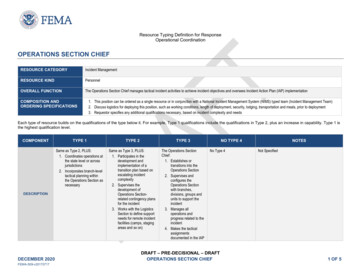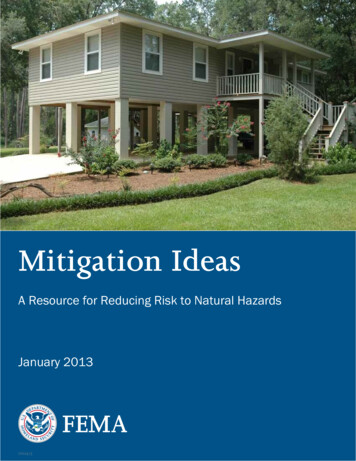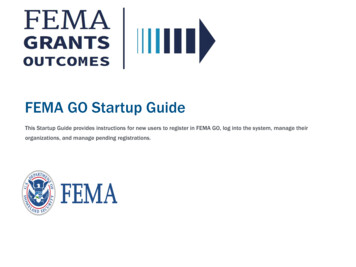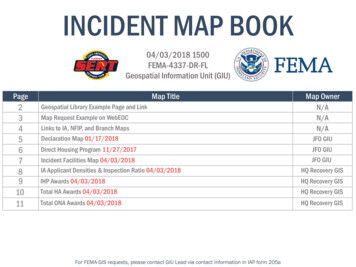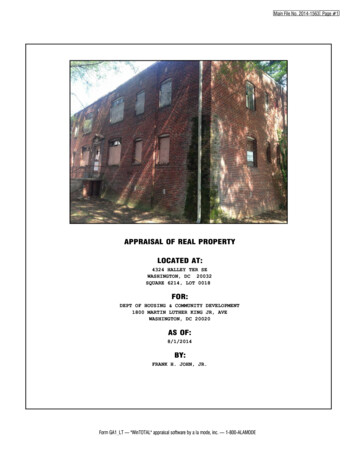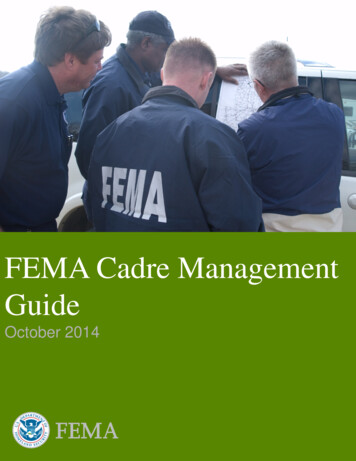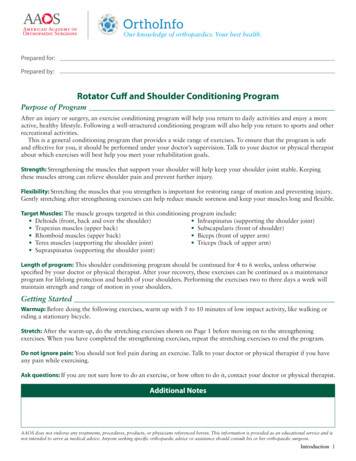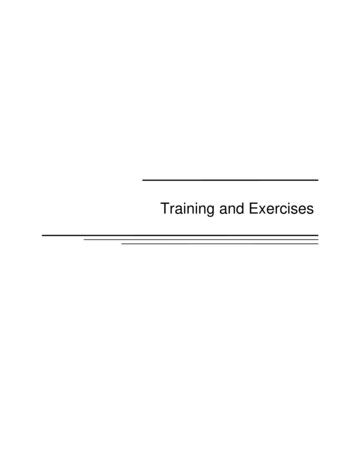
Transcription
Training and Exercises
Training and ExercisesObjectivesAt the end of this unit, the participants will be able to: Explain the steps involved in exercise development.List the types of exercises and the purposes of each.Identify the exercises required for the earthquake portion of their school’s Emergency OperationsPlan (EOP).ScopeThis unit covers the following topics: Unit IntroductionWhy Exercise the Plan?How To Exercise the Plan: Homeland Security Exercise and Evaluation Program (HSEEP)After Exercises: EvaluationTabletop ExerciseAdditional ResourcesUnit SummaryMethodologyThe instructor will begin the unit by the discussing the importance of training and exercising theschool’s earthquake response procedures with students and staff.The instructor will review the types of exercises that comprise the Homeland Security Exercise andEvaluation Program (HSEEP). Participants will then complete a final, tabletop exercise that presentsan earthquake scenario and asks them to apply what they learned about earthquake response.The instructor will conclude the unit with a description of additional Web resources that participantscan use to obtain information about training and exercising the earthquake portions of the EOP.May 2011Earthquake Safety for SchoolsInstructor GuidePage 1
Training and ExercisesTime PlanA suggested time plan for this unit is shown below. More or less time may be required, based on theexperience level of the group.TopicUnit IntroductionWhy Exercise the Plan?How To Exercise the Plan: HSEEPAfter Exercises: EvaluationTabletop ExerciseAdditional ResourcesUnit SummaryTotal TimePage 2Earthquake Safety for SchoolsInstructor GuideTime3 minutes25 minutes90 minutes15 minutes60 minutes15 minutes2 minutes3 hours 30 minutesMay 2011
Training and ExercisesTopicUnit IntroductionDisplayVisual 1Instructor Notes: Present the following key points.Training and exercises are both essential to a successful earthquake response. School staff, students,and parents need to know what to do after an earthquake.This unit introduces concepts of training and exercises and describes types of exercises that can be usedwith your school staff and students.May 2011Earthquake Safety for SchoolsInstructor GuidePage 3
Training and ExercisesTopicUnit Introduction (Continued)DisplayVisual 2Instructor Notes: Present the following key points.Once a school has developed an Emergency Operations Plan (EOP), teachers will participate in theeducation of staff, students, and parents and guardians about the emergency procedures. They will alsobe expected to participate in the planning and implementation of exercises to evaluate those procedures.At the end of this unit, the participants will be able to: Explain the steps involved in exercise development.List the types of exercises and the purposes of each.Identify the exercises required for the earthquake portion of their school’s Emergency OperationsPlan (EOP).Page 4Earthquake Safety for SchoolsInstructor GuideMay 2011
Training and ExercisesTopicWhy Exercise the Plan?DisplayVisual 3Instructor Notes: Present the following key points.Exercises are part of an ongoing preparedness cycle: Create an emergency response plan.Organize supplies, conduct training, and equip students and staff to implement the plan.Exercise the plan.Evaluate the results and identify areas for improvement in the plan. Then, repeat the cycle.The preparedness cycle ensures that specific capabilities that are inherent to a variety of scenarios (e.g.,evacuation and lockdown) are integrated into a workable plan to safeguard the school community.Capabilities provide the means to achieve a desired outcome by performing critical tasks, under specifiedconditions, to target levels of performance.May 2011Earthquake Safety for SchoolsInstructor GuidePage 5
Training and ExercisesTopicWhy Exercise the Plan? (Continued)DisplayVisual 4Instructor Notes: Present the following key points.Training on EOP procedures is critical to the successful implementation of those plans and procedures.Only through training can staff and students learn to follow the procedures correctly and to fulfill theirroles and responsibilities. Reunification of families will occur more quickly and more efficiently if all familymembers are trained in what to expect, what to do, how to do it, and where to go.Training is critical because it expands staff, student, and parent knowledge of earthquake procedures inthe EOP so that: Staff and students can follow procedures correctly.Staff and students can fulfill their roles and responsibilities.Families are reunified following an earthquake as quickly as possible.Exercises test the school’s earthquake procedures in the EOP and help to: Reveal training needs.Reveal planning weaknesses.Reveal resource needs.Improve coordination.Clarify roles and responsibilities.Improve individual performance.Identify a path forward.Page 6Earthquake Safety for SchoolsInstructor GuideMay 2011
Training and ExercisesTopicWhy Exercise the Plan? (Continued)DisplayVisual 5Instructor Notes: Conduct the following activity.Preparation: Divide the class into three groups and assign one group to identify training needs for staff,one group for students, and one group for parents.Purpose: This activity will enable the participants to identify capabilities (procedures) in the EOP thatshould be trained and exercised with students, staff, and parents.Estimated Time: 15 minutes (10 minutes activity 5 minutes debrief)Instructions:1. You will be assigned one of three target audiences: school staff, students, or parents.2. Working with your team, identify three earthquake skills from the EOP that you should train andexercise with your assigned audience.3. Be prepared to report your results in 10 minutes.Debrief:Ask:What capabilities did you identify for your assigned group?Acknowledge the responses. If not mentioned, provide the following examples: Students: Immediately performing “Drop-Cover-Hold” procedures during an earthquake, evacuatingthe building, and re-assembling the class at an outdoor location.May 2011Earthquake Safety for SchoolsInstructor GuidePage 7
Training and ExercisesTopicWhy Exercise the Plan? (Continued)Debrief: (Continued) Staff: Identifying and mitigating hazards in the classroom, evacuating the building, performing firstaid, and checking and shutting off utilities. Parents: Identifying and mitigating hazards in the home, staying informed after an earthquake (e.g.,locating information via the school Web site or email notifications), and following post-earthquakereunification procedures.Page 8Earthquake Safety for SchoolsInstructor GuideMay 2011
Training and ExercisesTopicHow To Exercise the Plan: HSEEPDisplayVisual 6Instructor Notes: Present the following key points.The Homeland Security Exercise and Evaluation Program (HSEEP) is a capabilities- and performancebased exercise program.HSEEP provides: A common exercise policy and program guidance.Consistent terminology that can be used and understood.Tools to plan, conduct, and evaluate exercises to improve overall preparedness.It is important to use HSEEP when developing earthquake exercises for your school.May 2011Earthquake Safety for SchoolsInstructor GuidePage 9
Training and ExercisesTopicHow To Exercise the Plan: HSEEPDisplayVisual 7Instructor Notes: Present the following key points.The HSEEP program identifies the following performance requirements for exercise programmanagement, design, development, conduct, evaluation, and improvement planning:1. Conduct an annual Training and Exercise Planning Workshop (TEPW), and maintain a MultiYear Training and Exercise Plan. The purpose of this workshop is to translate strategic goals andpriorities into specific training and exercise activities and to develop a schedule for those activities.2. Plan and conduct exercises in accordance with the guidelines set forth in HSEEP policy.Using a series of planning conferences, the design team ensures that the training and exercises arewell documented so that all participants are aware of the objectives, purpose, roles andresponsibilities, and exercise logistics. HSEEP policy guidance includes an overview of exerciseplanning and conduct, sample documents for all potential presentations, and manuals for all types ofexercises.3. Develop and submit a properly formatted After-Action Report/Improvement Plan (AAR/IP),based on observations of the relevant capabilities and tasks. Capture events as they occur during anexercise, analyze the events relative to exercise objectives, and suggest development actions toeither further enhance or improve agencies’ planning and response capabilities.4. Track and implement corrective actions identified in the AAR/IP to monitor progress (e.g.,identifying a need for additional training, equipment, exercises, coordination, or plans/procedures).Page 10Earthquake Safety for SchoolsInstructor GuideMay 2011
Training and ExercisesTopicHow To Exercise the Plan: HSEEP (Continued)DisplayVisual 8Instructor Notes: Present the following key points.The exercise planning team develops an overall exercise plan for your school. The team lists exercisesto develop and determines exercise sequence.The exercise planning team should be kept to a manageable size, but include all stakeholders, such as: One or more school administrator(s). The local emergency manager. The individual with overall responsibility for the school multihazard EOP, usually a staff member. Persons knowledgeable in the area to be tested.The team is organized using Incident Command System (ICS) structure and is responsible for: Determining the exercise objectives and scope. This includes identifying the section(s) of theEOP to be tested, the operations to carry out, and the skills, or Target Capabilities, that will bevalidated. Creating the scenario using the following guidelines: Exercise only the functions identified in the objectives. Don’t add unnecessary complications. Develop any associated exercise documentation. Plan for evaluation “up front,” including the evaluation measures Conducting any pre-exercise briefings and training. Conducting post-exercise analysis and creating plans for ongoing improvement.May 2011Earthquake Safety for SchoolsInstructor GuidePage 11
Training and ExercisesTopicHow To Exercise the Plan: HSEEP (Continued)DisplayVisual 9Instructor Notes: Present the following key points.Like the materials the participants design for all aspects of the school curriculum, earthquake training andexercises should be all-inclusive, age-appropriate, varied, and recurring.All-inclusive training is designed to include all intended target audiences. Examples include: Staff, such as administrators, teachers, substitute teachers, support staff (e.g., cafeteria workers,maintenance staff, custodians, bus drivers, and crossing guards), and volunteers.Students, including those with special needs or limited English proficiency.Parents and caregivers, including traditional and nontraditional family units (e.g., divorced/multiplehouseholds), and those with limited English proficiency.Age-appropriate training presents concepts in a manner that can be easily understood and ensures thatthe target audience is prepared, not frightened.Varied training helps create “new” interest in an “old” topic. Examples include: A formal earthquake preparedness curriculum, with prepared courses for all grade levels. Resourcesfor earthquake-specific curriculum development are available online and are listed in the resourcessection at the end of this unit.Reminder-level training, such as posters, signs, or a “tip of the day.”Earthquake activities that are linked to Standards of Learning (SOLs), such as hazard hunts forschool and home, storybooks, checklists, experiments, writing and drawing activities, or a themedscience fair.Page 12Earthquake Safety for SchoolsInstructor GuideMay 2011
Training and ExercisesTopicHow To Exercise the Plan: HSEEP (Continued)Varied Training (Continued) Guest speakers and classroom visitors, such as: Emergency management personnel. Search and rescue teams.Specialized skills training, such as Community Emergency Response Team (CERT or Teen CERT)training.Both small-scale and large-scale training exercises.Both discussion-based and hands-on training.Recurring training ensures that the plan doesn’t “gather dust” on the shelf. Periodic exercises providereminders and refresh learning.May 2011Earthquake Safety for SchoolsInstructor GuidePage 13
Training and ExercisesTopicHow To Exercise the Plan: HSEEP (Continued)DisplayVisual 10Instructor Notes: Present the following key points.HSEEP describes several types of exercises that are organized into two main categories: Discussion-based exercisesOperations-based exercisesEach category will be described in more detail on the next visuals.Page 14Earthquake Safety for SchoolsInstructor GuideMay 2011
Training and ExercisesTopicHow To Exercise the Plan: HSEEP (Continued)DisplayVisual 11Instructor Notes: Present the following key points.The first building blocks of an exercise program are discussion-based exercises. Discussion-basedexercises make participants familiar with current plans and procedures and may be used to develop newplans and procedures.Types of discussion-based exercises include the following: Seminars are informal discussions, presentations, or orientations to new or updated plans, policies,and procedures. Example: A seminar to inform staff of a new evacuation procedure. Workshops resemble a seminar, but build specific products, such as a draft plan or policy. Example:A training and exercise plan workshop to develop a Multi-Year Training and Exercise Plan. Tabletop exercises involve key personnel discussing hypothetical scenarios in an informal setting.This type of exercise involves indepth discussion and is used to assess the EOP and identifystrengths and shortfalls in the plan, policies, and procedures. Games use a multiplayer concept to create a dynamic decisionmaking environment. Games can besoftware based and competitive in nature and may involve playing against the computer or “system.”Additional information about tabletop exercises will be provided on the next few visuals.May 2011Earthquake Safety for SchoolsInstructor GuidePage 15
Training and ExercisesTopicHow To Exercise the Plan: HSEEP (Continued)DisplayVisual 12Instructor Notes: Present the following key points.In tabletop exercises, key personnel discuss simulated scenarios. The scenarios are often based onactual incidents at the school or recent events in the news, particularly from neighboring communities ornearby States.Tabletop exercises evaluate plans, policies, and procedures and help answer the question, “What if thatincident happened here?”A tabletop exercise requires one or more facilitators. The exercise paints a picture by presenting ascenario. The facilitator then: Asks open-ended questions related to the scenario, such as “What is your school policy in thissituation?”Encourages free-flowing discussion and avoids guiding the discussion.Page 16Earthquake Safety for SchoolsInstructor GuideMay 2011
Training and ExercisesTopicHow To Exercise the Plan: HSEEP (Continued)DisplayVisual 13Instructor Notes: Present the following key points.An earthquake tabletop exercise should include situations that challenge the procedures in your EOP andhelp identify shortfalls or areas for improvement.The exercise should include: Secondary hazards (e.g., fallen furniture and equipment, broken glass and debris, hazardousmaterial spills, fire, communications breakdowns, transportation system breakdowns, and poweroutages). Unusual circumstances (e.g., an earthquake during an assembly or when students are betweenclasses). Cascading events that increase the complexity of the incident over time, such as casualties, arearesidents arriving to use the school as a shelter, or parents attempting to circumvent reunificationprocedures.May 2011Earthquake Safety for SchoolsInstructor GuidePage 17
Training and ExercisesTopicHow To Exercise the Plan: HSEEP (Continued)DisplayVisual 14Instructor Notes: Present the following key points.Operations-based exercises validate plans and procedures, clarify roles and responsibilities, and identifyresource gaps in an operational environment.Types of operations-based exercises include the following: Drills are designed to be limited in focus and scope, and usually test a single, specific operation orfunction within a single entity. Examples include a school evacuation drill or a medical team drill. Functional exercises test specific plan functions, generally one function at a time. They focus oncoordination and command between agency coordination centers, but do not involve “boots on theground” (first responders or emergency officials responding to an incident in real time). Examples offunctional exercises include: Shelter in place and student care (overnight retention). Student accounting. Parent/student reunification. Medical treatment. Emergency public information. Logistics. Full-scale exercises are multiagency, multijurisdictional, multidiscipline exercises involving fullsupport systems (e.g., district central offices, district and community EOCs, school command posts).These exercises are “boots on the ground” responses that actually move resources, and are veryresource intensive. Such exercises also have considerable safety implications.Additional information about drills will be provided on the next few visuals.Page 18Earthquake Safety for SchoolsInstructor GuideMay 2011
Training and ExercisesTopicHow To Exercise the Plan: HSEEP (Continued)DisplayVisual 15Instructor Notes: Present the following key points.Drills provide a means to practice and perfect a single emergency response. They concentrate the effortsof a single function, such as evacuation or mobilizing the district command team, and provide “hands on”field experience.Features of a drill include: Coordination and supervision.Instant feedback.Narrow focus.Realistic environment.May 2011Earthquake Safety for SchoolsInstructor GuidePage 19
Training and ExercisesTopicHow To Exercise the Plan: HSEEP (Continued)DisplayVisual 16Instructor Notes: Present the following key points.Most drills will focus on priority actions that are required immediately after an earthquake.Examples of earthquake drills include: Mobilizing teams.Implementing a buddy system.Issuing student identification.Evacuating the school building.Containing hazardous materials spills.Extinguishing small fires.Using emergency communications.Shutting off utilities.**Note: Some utilities must be turned back on by the utility company. Coordination with the schoolFacility Department is extremely important.The list is not all-inclusive. Other types of drills could be important, depending on circumstances atindividual schools.Page 20Earthquake Safety for SchoolsInstructor GuideMay 2011
Training and ExercisesTopicHow To Exercise the Plan: HSEEP (Continued)DisplayVisual 17Instructor Notes: Conduct the following activity.Purpose: This activity will enable the participants to review a detailed school earthquake evacuation drill.Estimated Time: 15 minutes (10 minutes activity 5 minutes debrief)Instructions:1. Read through the Earthquake Simulation and Evacuation Drill in the Student Manual, including:Content Concepts, Objectives, Procedure, Learning Links, Reminders, Vocabulary, EarthquakeSimulation Script, and Drill and Evacuation Checklist.2. Answer the questions listed on the visual.3. Be prepared to discuss the drill in 10 minutes.Debrief:After 10 minutes, ask:Could you use this drill in your school?Were the instructions complete?Would you use a simulation script?Acknowledge the responses. Note that the participants will have an opportunity to adapt this drill, andimplement their own suggestions, in the second part of this activity.May 2011Earthquake Safety for SchoolsInstructor GuidePage 21
Training and ExercisesHow To Exercise the Plan: HSEEP (Continued)TopicEarthquake Simulation and Evacuation DrillSource: Earthquake Safety Activities for Children and Teachers (FEMA-527)Content Concepts1. Students can cope with hazards during evacuation.2. Students are first responsible for their own safety, but also can help if others are injured.3. After an earthquake, students can cope with the disturbed environment and their own emotionalreactions.ObjectivesStudents will: Identify hazards they might find during evacuation. Describe ways of helping others who are injured during earthquakes. Describe feelings they might have and dangers they might face after an earthquake.Learning Links Language Arts: Writing and reading hazard descriptions, discussing hazards and coping strategies,discussing and writing (older children) about what happens after an earthquake.Social Studies: Practicing Drop, Cover, and Hold and evacuation procedures, discussingresponsibility for one’s own safety in an emergency, and what can be done for others.Procedure1. Review classroom earthquake drill procedures with students and have them practice the Drop, Cover,and Hold routine. Do the drill with or without using the simulation script.2. Take the class to the cafeteria and school library and discuss quake-safe actions to take in each ofthese settings. Have the children demonstrate those actions.3. Tell students that during an earthquake it’s important to stay where they are and take immediatequake-safe action. After the ground stops shaking, it is time to evacuate the building. Explain someof the hazards that may exist even after the major quake has passed, including aftershocks, fires, liveelectrical wires, and fumes.4. Walk the class through your regular fire drill route to an open area outdoors that you have chosen inadvance. Ask students to make mental notes as they go along of things that might become hazardsduring an earthquake, and share their ideas when you reach your designated site. Write eachappropriate suggestion on an index card. The list of possible hazards may include:a. power failure (Is there emergency lighting available?)b. halls or stairways cluttered with debris (Are there lockers or trophy cabinets along hallwaysthat could fall and block your path?)c. smoke in the hallwayd. an exit door that jams and will not opene. an aftershock (Students should stop walking immediately and begin Drop, Cover, and Hold.)f. bricks, glass, and debris outside the doorwayg. electrical wires fallen on the groundPage 22Earthquake Safety for SchoolsInstructor GuideMay 2011
Training and ExercisesTopicHow To Exercise the Plan: HSEEP (Continued)Earthquake Simulation and Evacuation Drill (Continued)Procedure (Continued)5. Return to the classroom. Hand one of the students an index card with a description of a hazard.Discuss this hazard and its impact on evacuation. Continue handing out the cards, one at a time,until all the hazards have been discussed. Give students an opportunity to express ideas about howthey can cope with the hazards and evacuate safely.RemindersFor the Teacher Take cover.Talk calmly to students.Give instructions for evacuation or other emergency.When No Shelter Is AvailableMove to an inside wall. Kneel next to the wall, facing away from windows. Bend head close to knees,cover sides of head with elbows, and clasp hands behind neck. If a coat is available, hold it over yourhead for protection from flying glass, and ceiling debris.Earthquake Safety Reminders for StudentsIf you’re inside: Stay inside. Take cover immediately under a table, desk, or counter. Keep quiet and listen for instructions. Remain in safe position for at least 60 seconds, or until the shaking has stopped and your teachertells you to leave your shelter.If you’re outside: Stay outside. Go to an open area away from hazards. Keep quiet and listen for instructions.If you are in a school bus or a car when the quake starts shaking: The driver should stop as soon as possible away from buildings, power lines, bridges, and highwayoverpasses and underpasses. Passengers should stay in the vehicle and hold on (cars and buses have “shock” absorbers).Vocabularye vac u a tion – Evacuation is the act of emptying completely. When we evacuate a building, we want toleave it quickly, quietly, and safely.fore shock – A foreshock is an earthquake which comes before the main quake and is less severe.af ter shock – An aftershock is an earthquake which follows a major quake and is less severe.May 2011Earthquake Safety for SchoolsInstructor GuidePage 23
Training and ExercisesTopicHow To Exercise the Plan: HSEEP (Continued)Earthquake Simulation and Evacuation Drill (Continued)Drop, Cover, and Hold RoutinePage 24Earthquake Safety for SchoolsInstructor GuideMay 2011
Training and ExercisesTopicHow To Exercise the Plan: HSEEP (Continued)Earthquake Simulation and Evacuation Drill (Continued)Earthquake Simulation ScriptImagine that you hear a low, rumbling, roaring sound. The noise builds, getting louder and louder, for afew seconds. Then, Wham! There’s a terrific jolt. You feel like someone suddenly slammed on thebrakes in the car, or like a truck just rammed into the side of the building.The floor seems to be moving beneath you. It’s hard to stand up, or even stay in your seat. If you dostand up, you might feel like you’re riding a raft down a fast river. When you walk, it’s like trying to walkon a trampoline or a waterbed. You hear someone say, “Earthquake! Drop, Cover, and Hold!”I want all of you at your desks to take cover as quickly and quietly as you can, right now. Please listenvery carefully.The shaking and commotion may last about 60 seconds or a little longer. We’ll have our timer count offthe seconds for as long as this earthquake lasts. [The timer may begin counting softly now.]The building is creaking and rattling. Books are falling from the bookcase. Hanging lamps and plants areswaying. Suddenly a pot falls to the floor and smashes, and the plant spills. A window pane justshattered, and glass is falling to the floor. The table is sliding, too.Be sure to stay in the drop, cover, and hold position under your desk. If your desk is moving, grab thelegs and move with it.You hear noises outside. Dogs are barking. Cats are meowing. A baby is crying. People are shoutingand screaming. The shaking is making church bells ring. You hear crashing sounds, from brick chimneysand other loose parts of the building falling to the ground. Trees outside are swaying and scrapingagainst the walls.Inside the room, pictures are moving on their nails. Oh! That one just fell off the wall and crashed to thefloor. The desk drawers are sliding open. The lights begin to flicker on and off. they just went out! Nowthe door swings back and forth on its hinges. Bang! It slams shut. There’s silence now. Just assuddenly as the noise and shaking began, the room grows quiet. [The timer can stop counting now.]Please, everyone, get back in your seats. It is important to remain very quiet and wait for instructions.When it is safe to leave the building, I am going to lead you outside to an open space. Stay together, andbe ready to take cover again at any moment, because the shaking may start again. Sometimes otherquakes, called aftershocks, occur after the damaging earthquake has stopped.Source: HELP: Hands-on Earthquake Learning Package, California Edition (1983). EnvironmentalVolunteers, Inc.May 2011Earthquake Safety for SchoolsInstructor GuidePage 25
Training and ExercisesTopicHow To Exercise the Plan: HSEEP (Continued)Earthquake Simulation and Evacuation Drill (Continued)Drill and Evacuation ChecklistDid everyone know what to do when told to Drop, Cover, and Hold?Did everyone follow the procedure correctly?In the classroom, the library, or the cafeteria, was there enough space for all the students underdesks, tables, or counters?In the gym or in the hallways, were students able to take shelter away from windows, light fixtures,trophy cases, and other hazards?Do students know how to protect themselves if they are on the playground during an earthquake? Ifthey are in a school bus or a car?Did everyone remain quietly in their safe positions for at least 60 secondsDid students with special needs participate in the drill and evacuation?Did we remember to take our emergency kit and class roster when we evacuated the classroom?Did everyone go to the safe outdoor area in an orderly way?If we had to change our evacuation route to get to the safe area, did we make wise decisions?Page 26Earthquake Safety for SchoolsInstructor GuideMay 2011
Training and ExercisesTopicHow To Exercise the Plan: HSEEP (Continued)DisplayVisual 18Instructor Notes: Conduct the following activity.Preparation: This is an optional activity and can be conducted if time permits. The activity may be toonly discuss the changes made to the drill or to actually run the drill, as revised. Divide the class intogroups and assign each group a different location or situation that suits the needs of your school. Samplelocations include: A classroom.The cafeteria or auditorium.On the bus.An outside location.Purpose: This activity will enable the participants to adapt the earthquake simulation and evacuation drillreviewed in the previous activity to a different location or situation.Estimated Time: 45 minutes (30 minutes activity 15 minutes debrief)Instructions:1. Work in your assigned groups.2. Revise the Earthquake Simulation and Evacuation Drill from the previous activity, including theprocedure, script, and checklist, to fit the new location or situation assigned by the instructor.3. Be prepared to discuss or run your revised drill in 30 minutes.May 2011Earthquake Safety for SchoolsInstructor GuidePage 27
Training and ExercisesTopicHow To Exercise the Plan: HSEEP (Continued)Debrief:After 30 minutes, ask each group to run their revised dril
Training and Exercises May 2011 Earthquake Safety for Schools Page 3 Instructor Guide Topic Unit Introduction Display Visual 1 Instructor Notes: Present the following key points. Training and exercises are both essential to a successful earthquake response. School staff, students, and parents need to know what to do after an earthquake.
